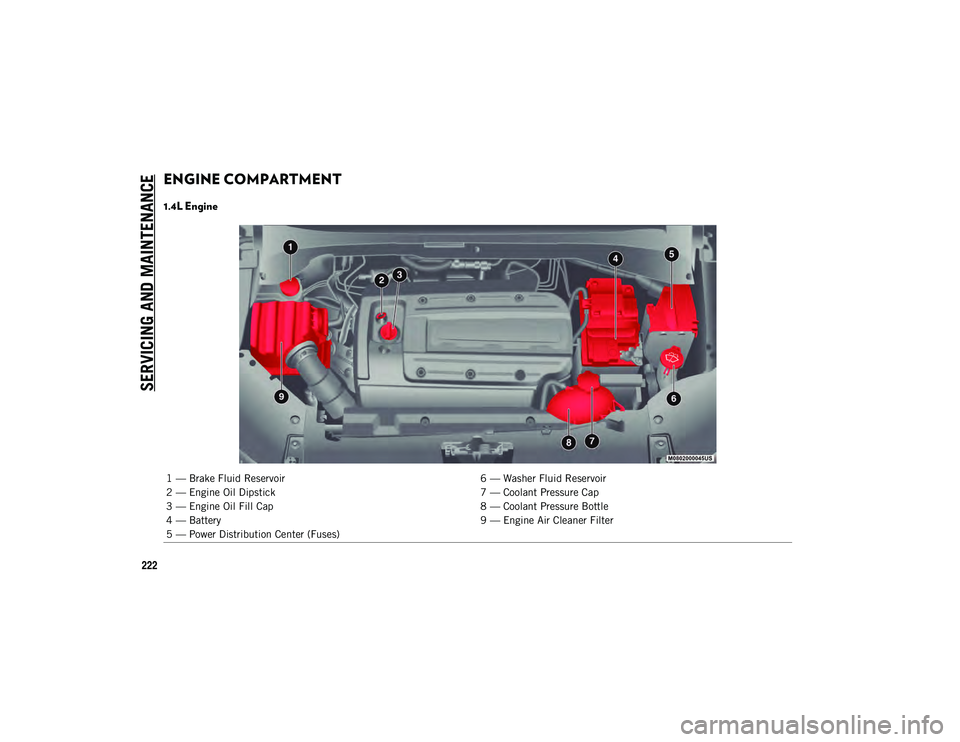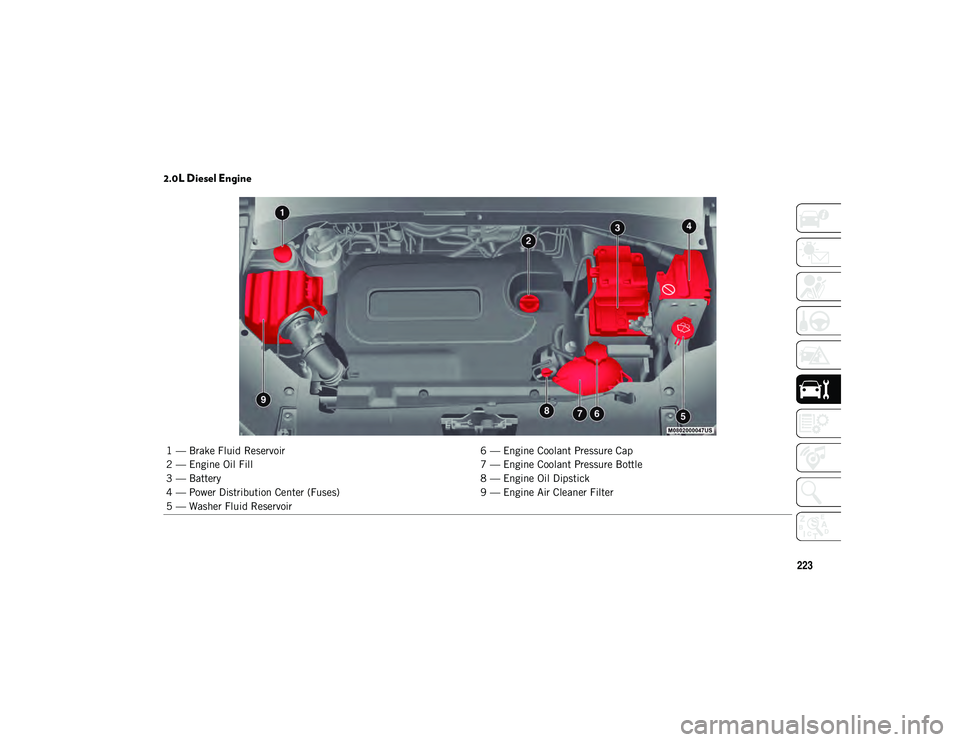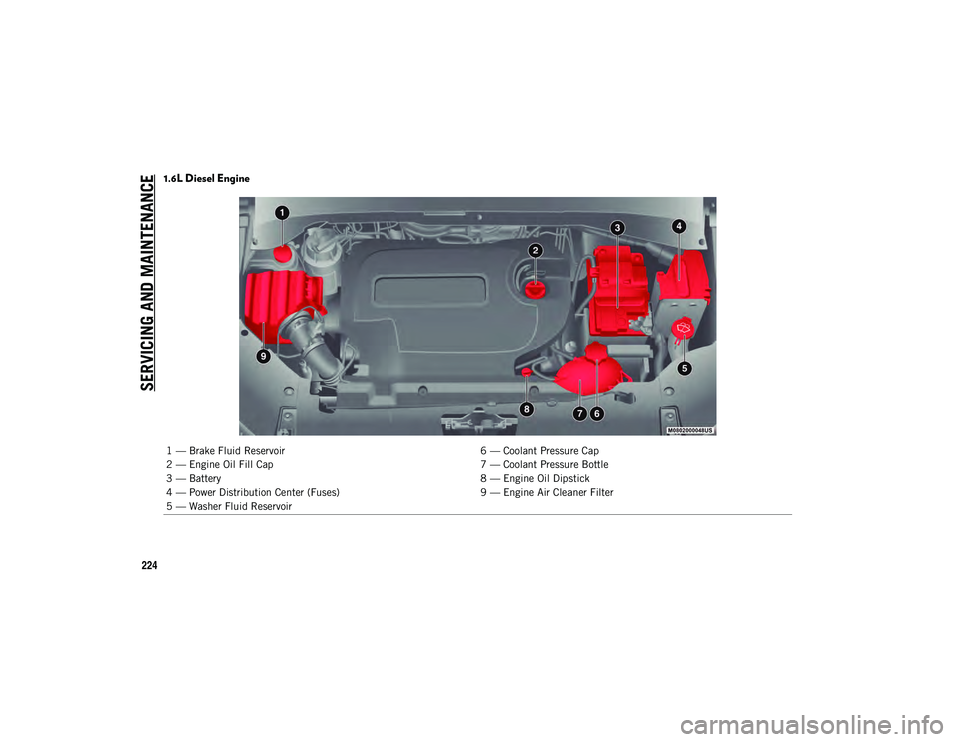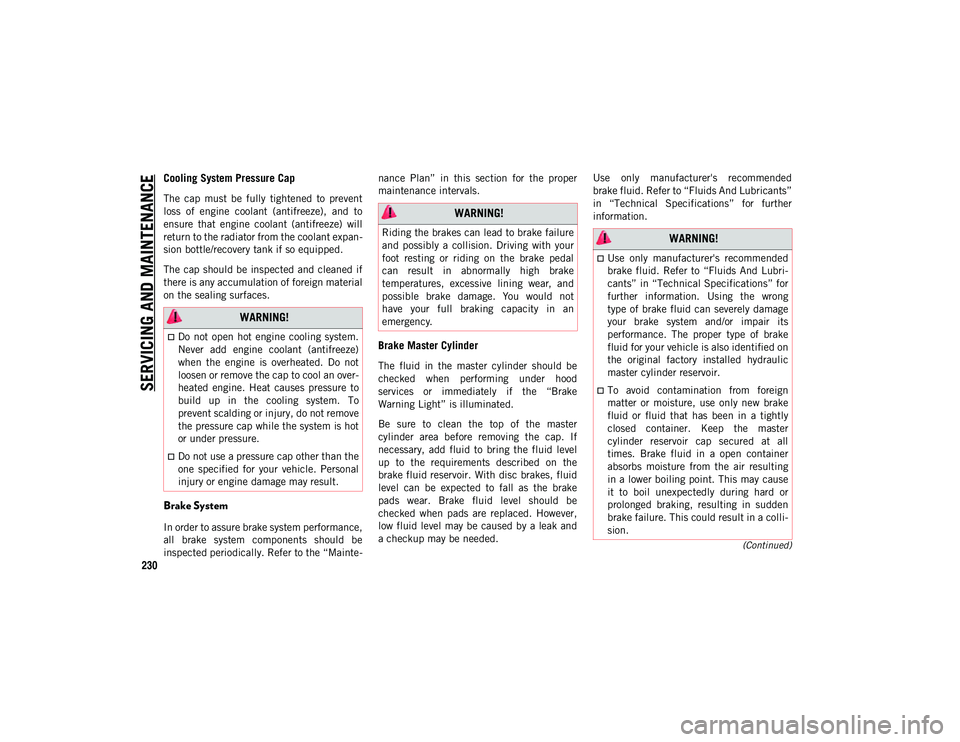coolant reservoir JEEP COMPASS 2020 Owner handbook (in English)
[x] Cancel search | Manufacturer: JEEP, Model Year: 2020, Model line: COMPASS, Model: JEEP COMPASS 2020Pages: 328, PDF Size: 8.85 MB
Page 224 of 328

SERVICING AND MAINTENANCE
222
ENGINE COMPARTMENT
1.4L Engine
1 — Brake Fluid Reservoir6 — Washer Fluid Reservoir
2 — Engine Oil Dipstick 7 — Coolant Pressure Cap
3 — Engine Oil Fill Cap 8 — Coolant Pressure Bottle
4 — Battery 9 — Engine Air Cleaner Filter
5 — Power Distribution Center (Fuses)
2020_JEEP_M6_UG_UK.book Page 222
Page 225 of 328

223
2.0L Diesel Engine
1 — Brake Fluid Reservoir6 — Engine Coolant Pressure Cap
2 — Engine Oil Fill 7 — Engine Coolant Pressure Bottle
3 — Battery 8 — Engine Oil Dipstick
4 — Power Distribution Center (Fuses) 9 — Engine Air Cleaner Filter
5 — Washer Fluid Reservoir
2020_JEEP_M6_UG_UK.book Page 223
Page 226 of 328

SERVICING AND MAINTENANCE
224
1.6L Diesel Engine
1 — Brake Fluid Reservoir6 — Coolant Pressure Cap
2 — Engine Oil Fill Cap 7 — Coolant Pressure Bottle
3 — Battery 8 — Engine Oil Dipstick
4 — Power Distribution Center (Fuses) 9 — Engine Air Cleaner Filter
5 — Washer Fluid Reservoir
2020_JEEP_M6_UG_UK.book Page 224
Page 232 of 328

SERVICING AND MAINTENANCE
230
(Continued)
Cooling System Pressure Cap
The cap must be fully tightened to prevent
loss of engine coolant (antifreeze), and to
ensure that engine coolant (antifreeze) will
return to the radiator from the coolant expan-
sion bottle/recovery tank if so equipped.
The cap should be inspected and cleaned if
there is any accumulation of foreign material
on the sealing surfaces.
Brake System
In order to assure brake system performance,
all brake system components should be
inspected periodically. Refer to the “Mainte -nance Plan” in this section for the proper
maintenance intervals.
Brake Master Cylinder
The fluid in the master cylinder should be
checked when performing under hood
services or immediately if the “Brake
Warning Light” is illuminated.
Be sure to clean the top of the master
cylinder area before removing the cap. If
necessary, add fluid to bring the fluid level
up to the requirements described on the
brake fluid reservoir. With disc brakes, fluid
level can be expected to fall as the brake
pads wear. Brake fluid level should be
checked when pads are replaced. However,
low fluid level may be caused by a leak and
a checkup may be needed.
Use only manufacturer's recommended
brake fluid. Refer to “Fluids And Lubricants”
in “Technical Specifications” for further
information.
WARNING!
Do not open hot engine cooling system.
Never add engine coolant (antifreeze)
when the engine is overheated. Do not
loosen or remove the cap to cool an over
-
heated engine. Heat causes pressure to
build up in the cooling system. To
prevent scalding or injury, do not remove
the pressure cap while the system is hot
or under pressure.
Do not use a pressure cap other than the
one specified for your vehicle. Personal
injury or engine damage may result.
WARNING!
Riding the brakes can lead to brake failure
and possibly a collision. Driving with your
foot resting or riding on the brake pedal
can result in abnormally high brake
temperatures, excessive lining wear, and
possible brake damage. You would not
have your full braking capacity in an
emergency. WARNING!
Use only manufacturer's recommended
brake fluid. Refer to “Fluids And Lubri -
cants” in “Technical Specifications” for
further information. Using the wrong
type of brake fluid can severely damage
your brake system and/or impair its
performance. The proper type of brake
fluid for your vehicle is also identified on
the original factory installed hydraulic
master cylinder reservoir.
To avoid contamination from foreign
matter or moisture, use only new brake
fluid or fluid that has been in a tightly
closed container. Keep the master
cylinder reservoir cap secured at all
times. Brake fluid in a open container
absorbs moisture from the air resulting
in a lower boiling point. This may cause
it to boil unexpectedly during hard or
prolonged braking, resulting in sudden
brake failure. This could result in a colli -
sion.
2020_JEEP_M6_UG_UK.book Page 230